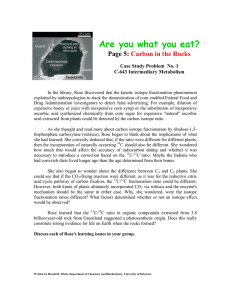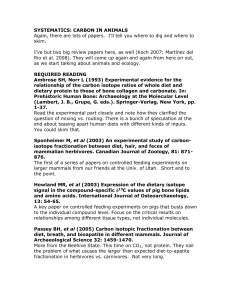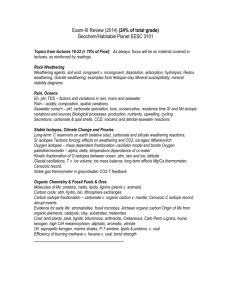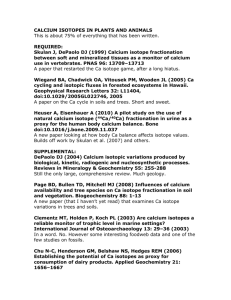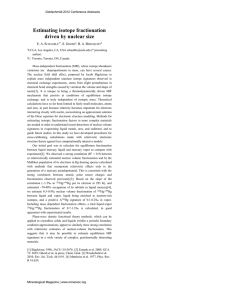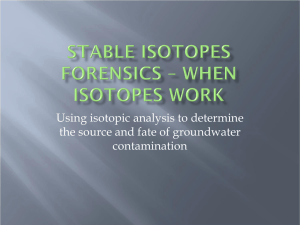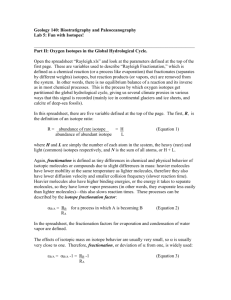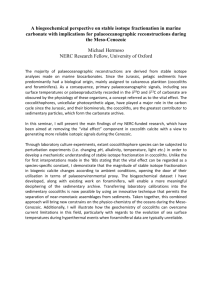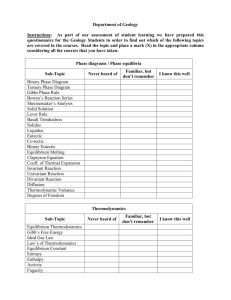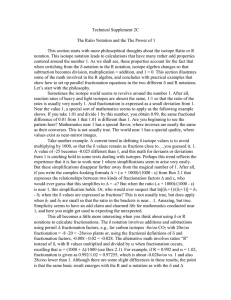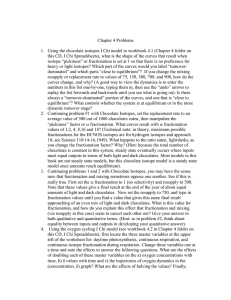Isotopic Fossils
advertisement
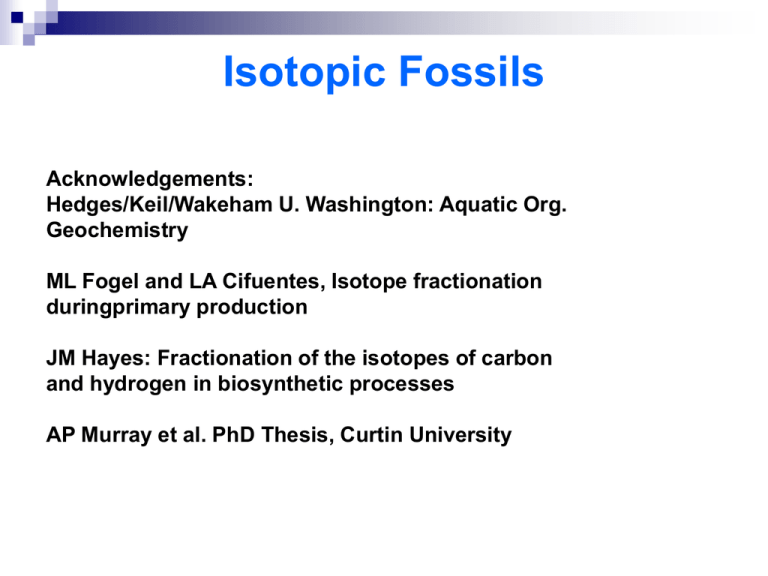
Isotopic Fossils Acknowledgements: Hedges/Keil/Wakeham U. Washington: Aquatic Org. Geochemistry ML Fogel and LA Cifuentes, Isotope fractionation duringprimary production JM Hayes: Fractionation of the isotopes of carbon and hydrogen in biosynthetic processes AP Murray et al. PhD Thesis, Curtin University Light Isotope Abundances & Effects Reactant An Isotope Effect is a phenomenon arising from the mass difference between two isotopes Product Fractionation an observable quantity Question: what’s incongruent about this? Origins of Mass Dependent Isotopic Fractionation Equilibrium in a reversible reaction, where the heavier isotope concentrated in the more strongly bonded form: 13CO 2(g) + H12CO3-(aq) = 12CO2(g) + H13CO3-(aq) Different rates of diffusive transport where: 12CO 2 diffuses ~1% faster than 13CO2 Different rates of reaction in kinetically controlled conversions - the light isotope tends to react faster: most biochemistry Principles of Isotopic Measurement Either a pure gas via a duel inlet system for sample and standard Or a stream of gas containing sample ‘slugs’ interspersed with standard ‘slugs’ Terminology NB Standard for δ18O/16O in carbonates is PDB Terminology α = is the kinetic fractionation factor = Where p is product, s is substrate, h is heavy and l is light. Written precisely this is A general approximation is ε is also called the isotope effect or epsilon !! Equilibrium isotope effects are simply related to kinetic effects by a = k2/k1 Some Equilibrium Isotope Effects Isotopic compositions of materials in a reaction network are complex to compute but can be very informative about processes in food chains and also biosynthetic pathways. The reactions which have most effect are not necessarily the ones with bigger e. Fractionation of C-Isotopes during Autotrophy Theoretical max. depletion from RUBISCO from CO2 atm (-7‰) & e = 29.4 therefore δ13C biomass -36.4‰ Usually, a much lower fractionation is observed eg δ13C biomass of plants is roughly -27‰ ie ε = 20‰ Theoretical models and practical experiments show that [CO2] inside and outside are different and controlled by diffusion through the stomata. ε not maximal as a result of water relations and minimization of transpiration ε = α + (Ci/Ca) (β-α) where α fractionation factor for diffusion and b is the fractionation factor for C-fixation. If Ci/Ca is 1, ie unlimited CO2, e controlled by β. If Ci/Ca <<1 ε controlled by α Fractionation of C-Isotopes during Autotrophy Formation of oxaloacetate from PEP (Phosphoenolpyruvate) catalysed by PEP carboxylase C4 pathway Mesophyll cell Bundle-Sheath cell Question: What are the differences between C4 and CAM plants?? Fractionation of C-Isotopes during Autotrophy Questions: What is the distinction between C4 pathway and C4 plants What does RUBISCO stand for? What does the RUBISCO do when CO2 is low and light is high Is this good or bad for the plant? What advantages does C4 pathway confer on plants that use it? Observations: C4 evolution seen in the Cenozoic C-isotopic record of terrestrial organic matter and also in teeth of grazing animals Cerling, T. E., Ehleringer, J. R., and Harris, J. M., 1998, Carbon dioxide starvation, the development of C4 ecosystems, and mammalian evolution. Philosophical Transactions of the Royal Society B. 353: 159-171. Cerling, T. E., Harris, J. M., 1999, Carbon isotope fractionation between diet and bioapatite in ungulate mammals and implications for ecological and paleoecological studies. Oecologia 120: 347-363. Cerling, T. E., Harris, J. M., and Leakey, M. G., 1999, Browsing and grazing in modern and fossil proboscideans. Oecologia 120: 364-374. Ekart, D. D. and T. E. Cerling, 1999, A 400 million year carbon isotope record of pedogenic carbonate: Implications for atmospheric carbon dioxide. American Journal of Science. 299: 805-817. Cerling, T. E., J. M. Harris, B. J. MacFadden, 1998, Carbon isotopes, diets of North American equids, and the evolution of North American C4 grasslands. In (Griffiths, H., Ed.)Stable Isotopes and the Integration of Biological, Ecological, and Geochemicial Processes.. Bios Scientific Publishers, Oxford, p. 363-379. Natural Variability in Bulk C-Isotopes Intramolecular C-isotopic Differences (DeNiro and Epstein, 1977; Monson and Hayes, 1980,1982; reviewed Hayes, 2001) Reactions occur between molecules but isotope selectivity is expressed as chemical bonds that are made or broken at particular carbon positions. Isotope effects pertain to those specific positions and control fractionations only at that reaction site, not throughout the whole molecule. To calculate changes in the isotopic compositions of whole molecules we must first calculate the change at the site and then allow for the rest of the molecule because the isotopic shift is diluted by mixing with carbon that is just along for the ride………………..Hayes, 2001 Two Origins for Isoprenoids The major nonbiological fractionation process affecting stable hydrogen (and oxygen) isotopes is the hydrologic cycle in which water molecules containing lighter isotopes (1H & 16O) are preferentially evaporated and retained in a cloud (vs. 2H & 18O). The net result of this fractionation process is that precipitation at increasingly inland, higher altitude (cooler) sites is depleted in both 18O and 2H (D). In general, tree sap isotopically resembles local meteoric water, whereas leaf water is isotopically depleted. Organic matter is depleted in D versus the leaf water from which it is biosynthesized (values given above are typical for N. American plants). In general, lipids are depleted in D versus lignin and cellulose from the same plant, whereas cellulose is slightly more depleted than coexisting lignin (Rundle et al., 1989). Cellulose is usually analyzed in nitrated form (NO3 replacing OH on each C), so that only the nonexchangeable H directly bound to C is analyzed. Because the D in cellulose nitrate reflects local water, woods can be used as a proxy for the hydrogen isotope composition of past environments in which the wood was made
